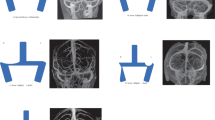Abstract
Introduction
Transverse sinus tapered narrowings are frequently identified in patients with idiopathic intracranial hypertension (IIH); however, it remains unclear whether they are primary stenoses or whether they occur secondary to raised cerebrospinal fluid pressure. Computed tomographic venography demonstrates both the morphology of the venous system and the adjacent bony grooves so it may provide an insight into the aetiology of these transverse sinus stenoses.
Materials and methods
Tapered transverse sinus narrowings (>50%) were studied in 19 patients without IIH and 14 patients with IIH. Computed tomography vascular studies were reviewed and the dimensions of the venous sinuses and bony grooves at the sites of maximum and minimum transverse sinus area dimensions were recorded.
Results
There was demonstrated to be a strong correlation of bony groove height with venous sinus height at the largest portions of the transverse sinus in both IIH patients and non-IIH subjects as well as at the transverse sinus narrowing in non-IIH subjects. There was a discordant relationship between bony groove height and venous sinus height at the site of transverse sinus stenoses in IIH patients. In 5/23 IIH transverse sinus stenoses, the bony groove height was proportionate to that seen in non-IIH subjects. There were a further 8/23 cases where the small or absent sinus was associated with an absent bony groove.
Conclusion
Transverse sinus tapered narrowings in subjects without IIH and in the majority of patients with IIH were associated with proportionately small or absent grooves, and these are postulated to be primary or fixed. Some patients with IIH demonstrate tapered transverse sinus stenoses with disproportionately large bony grooves, suggesting a secondary or acquired narrowing. This implies a varied aetiology for the transverse sinus stenoses of IIH.







Similar content being viewed by others
References
Farb RI, Vanek MD, Scott JN et al (2003) Idiopathic intracranial hypertension. The prevalence and morphology of sinovenous stenosis. Neurology 60:1418–1424
Higgins JN, Gillard JH, Owler BK, Harkness K, Pickard JD (2004) MR venography in idiopathic intracranial hypertension: unappreciated and misunderstood. J Neurol Neurosurg Psychiatry 75:621–625
Johnston I, Kollar C, Dunkley S, Assaad N, Parker G (2002) Cranial venous outflow obstruction in the pseudotumour syndrome: incidence, nature and relevance. J Clin Neurosci 9:273–278
Karahalios DG, Rekate HL, Khayata MH, Apostolides PJ (1996) Elevated intracranial venous pressure as a universal mechanism in pseudotumour cerebri of varying etiologies. Neurology 46:198–202
King JO, Mitchell PJ, Thomson KR, Tress BM (1995) Cerebral venography and manometry in idiopathic intracranial hypertension. Neurology 45:2224–2228
King JO, Mitchell PJ, Thomson KR, Tress BM (2002) Manometry combined with cervical puncture in idiopathic intracranial hypertension. Neurology 58:26–30
Johnston I, Hawke S, Halmagyi M, Teo C (1991) The pseudotumour syndrome. Disorders of cerebrospinal fluid circulation causing intracranial hypertension without ventriculomegaly. Arch Neurol 48:740–747
Donnet A, Metellus P, Levrier O et al (2008) Endovascular treatment of idiopathic intracranial hypertension: clinical and radiologic outcome of 10 consecutive patients. Neurology 70:641–647
Higgins JN, Owler BK, Cousins C, Pickard JD (2002) Venous stenting for refractory benign intracranial hypertension. Lancet 359:228–230
Higgins JN, Cousins C, Owler BK, Sarkies N, Pickard JD (2003) Idiopathic intracranial hypertension: 12 cases treated by venous stenting. J Neurol Neurosurg Psychiatry 74:1662–1666
Higgins JN, Pickard JD (2004) Lateral sinus stenoses in idiopathic intracranial hypertension resolving after CSF diversion. Neurology 25:1907–1908
Baryshnik DB, Farb RI (2004) Changes in the appearance of venous sinuses after treatment of disordered intracranial pressure. Neurology 62:1445–1446
De Simone R, Marano E, Fiorillo C et al (2005) Sudden re-opening of collapsed transverse sinuses and longstanding clinical remission after a single lumbar puncture in a case of idiopathic intracranial hypertension. Pathogenetic implications. Neurol Sci 25:342–344
Rohr A, Dorner L, Stingele R, Buhl R, Alfke K, Jansen O (2007) Reversibility of venous sinus obstruction in idiopathic intracranial hypertension. Am J Neuroradiol 28:656–659
Scoffings DJ, Pickard JD, Higgins JNP (2007) Resolution of transverse sinus stenoses immediately after CSF withdrawal in idiopathic intracranial hypertension. J Neurol Neurosurg Psychiatry 78:911–912
Bisaria KK (1985) Anatomic variations of venous sinuses in the region of the torcular Herophili. J Neurosurg 62:90–95
Dora F, Zileli T (1980) Common variations of the lateral and occipital sinuses at the confluens sinuum. Neuroradiology 20:23–71
Newton TH, Potts DJ (1974) Radiology of the skull and brain: angiography. Mosby, St Louis, pp 1851–1902
Hunerbein R, Reuter P, Meyer W, Kuhn FP (1997) CT angiography of cerebral venous circulation: anatomical visualization and diagnostic pitfalls in interpretation. Rofo 167:612–618
Alper F, Kantarci M, Dane S, Gumustekin K, Onbas O, Durur I (2004) Importance of anatomical asymmetries of transverse sinuses: an MR venographic study. Cerebrovasc Dis 18:236–239
Ayanzen RH, Bird CR, Keller PJ, McCully FJ, Theobald MR, Heiserman JE (2000) Cerebral MR Venography: normal anatomy and potential diagnostic pitfalls. Am J Neuroradiol 21:74–78
Leach JL, Jones BV, Tomsick TA, Stewart CA, Balko MG (1996) Normal appearance of arachnoid granulations on contrast-enhanced CT and MR of the brain: differentiation from dural sinus disease. Am J Neuroradiol 17:1523–1532
Bono F, Giliberto C, Mastrandrea C, Cristiano D, Lavano A, Fera F, Quattrone A (2005) Transverse sinus stenoses persist after normalisation of the CSF pressure in IIH. Neurology 65:1090–1093
Conflict of interest statement
We declare that we have no conflict of interest.
Author information
Authors and Affiliations
Corresponding author
Rights and permissions
About this article
Cite this article
Connor, S.E.J., Siddiqui, M.A., Stewart, V.R. et al. The relationship of transverse sinus stenosis to bony groove dimensions provides an insight into the aetiology of idiopathic intracranial hypertension. Neuroradiology 50, 999–1004 (2008). https://doi.org/10.1007/s00234-008-0431-5
Received:
Accepted:
Published:
Issue Date:
DOI: https://doi.org/10.1007/s00234-008-0431-5




